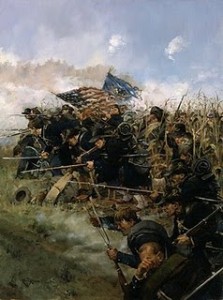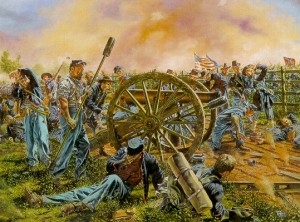The American Civil War has so many teaching points and moments of inspiration for those concerned with the preservation of western civilization’s higher ideals that it bears constant review and re-focus. Though framed as a battle between “free” and “slave” states, it reached violent fruition in 1861 as a rebellion initiated by states determined to maintain their own principles of governance and a federal government determined to preserve a national union of states. It became clear in a short time that the battle over a state’s right to self governance and self determination, assumed by all to be a likely brief spasm of violence, had evolved into a cataclysmic trans-continental struggle for multiple principles of individual rights and individual servitude, with entirely opposing views as to who’s rights and who’s freedoms were being subjugated.
By 1862 the war was assuming a frightful mass and scope predicted by few in power and the costs in lives and economy was beginning to reach into every household. The Union government holding dramatic advantages in infrastructure, manpower, and economic capacity found itself floundering in the most important expression of the righteousness of its argument to hold the union together along its former construct – victories on the battlefield. How does one win the victory of ideas when the means to enforce them are not present? How long will ideas maintain their energy when the sacrifices required to defend them reach epic levels without an end in sight? These were the extraordinarily difficult circumstances that were placed upon President Lincoln as 1862 was rushing to a close. He had faced a year of enormous financial and manpower commitment on his nation’s part placed in the hands of a sluggish and peevish General McClellan, who devised expensive and crawling campaigns on the Virginian peninsula that despite overwhelming capacities placed in his favor, never felt he was given remotely sufficient support, and achieved no headway against a superior general named Lee and his flexible, rapid movement modern tactics. Thousands of deaths and tens of millions of dollars of equipment lost, and the result of the Peninsula war and ignominious Union withdrawal. President Lincoln was caught in the crosshairs- no country would absorb loss forever and no country would fight on principle forever. If he was to re-frame the war onto a framework that potentially could survive the enormous pain and trans-continental scope of the evolved war – turning the war into a battle test no longer of the rights of states but rather, the Rights of Man – he needed a victory, and he needed it now.
September, 1862, brought this moment to a pressure point just outside of the little town of Sharpsburg, Maryland along a creek named Antietam. General Lee now fully in charge of the Army of Northern Virginia, the primary military expression of the confederate states, felt the time was right and his force quality advantage sufficient to press the battle for the first time into the Union states, potentially drawing the north into a truce that would accept the south. The north had shown no conclusive ability to marshall forces and multiple examples of inept generalship. Lee recognized his own limited window for achieving the necessary victories and aggressively moved to press a conclusion. On September 17th, 1862, on Antietam Creek 40,000 confederate soldiers and 75,000 union soldiers clashed in the most violent single day expression of war in American history, with a resultant 23,000 casualties in one 24 hour period. The elements of the battle are legendary both in their heroism and moments of ineptness, but are brought to incredible and intense focus, in what has been immortalized in the battle for “the Cornfield” – where thousands of men fought blindly and frequently in vicious individual hand to hand combat with no perspective other than their own and their comrade’s basic survival. It is in the Cornfield that North’s legendary Iron Brigade comprised of Midwesterners primarily from 2nd, 6th , and 7th Wisconsin Voluntary Infantry , as well as elements from Indiana and Michigan, held their ground and beat back the previously unconquerable forces of Stonewall Jackson, and earned their fearsome reputation that lasted through the rest of the civil war.



The enormous scope of the battle and its horrifying cost riveted the nation on both sides of the conflict. McClellan had at last succeeded at halting a confederate army and although not conclusive, forced Lee to retrench his forces back into Virginia, thereby ending any hopes for the south of a conclusive end to the conflict in their favor.
For Lincoln it was the victory he needed to convert the war into a battle for principles worthy of its size and cost. On the basis of the battle result at Antietam, he determined to make the Civil War rather than a second american revolution desired by the southern states, a final resolution of the loose ends of the first american revolution, to put to final test the principle that all men are created equal and that this country could not survive without the universal acceptance of that idea. Antietam allowed Lincoln the philosophical breathing space he needed to put forth the Emancipation Proclamation – and the war between the states became the battle for freedom and the end expression of the highest ideals of western civilization.